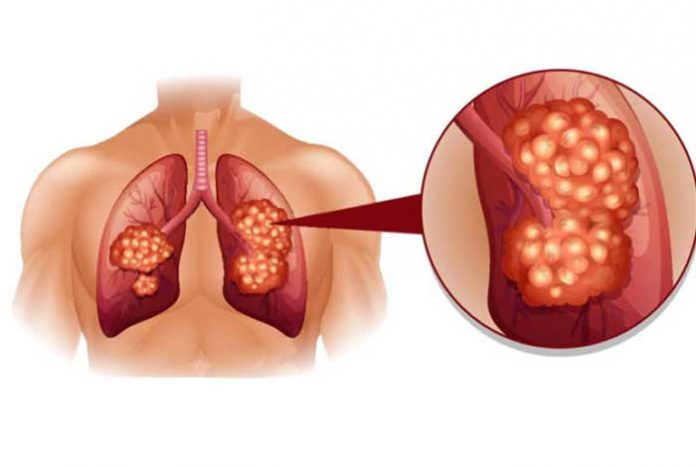
Overview and Facts
Lung cancer is an abnormal growth of cells arising in the lungs and is mostly seen in smokers. This abnormal growth of cells is scientifically termed as cancer or carcinoma. Cell growth is a normal phenomenon which as per the need of the individual, produces new cells. Normally, our body has a mechanism to keep a check on this growth of cells.
However, when this mechanism becomes ineffective or genes undergo mutation, the cells grow abnormally, giving rise to several abnormal cells. These abnormal cells are known as tumor cells. Not all tumors are cancerous. If the tumor cells invade the adjacent healthy tissues, the tumor is said to be cancerous (also known as malignant). When this malignancy originates in the lungs, it is known as lung cancer.
Lung cancer is the second most common cancer in men (first being prostate cancer) and women (first being breast cancer). However, lung cancer is the most common cause of death due to cancer in both men and women. As per a recent estimate by American Cancer Society, about 2,34,030 new cases of lung cancer will arise and approximately 1,54,050 cases of death due to lung cancer will be reported by 2018. [1]
Lungs are a pair of spongy organs, situated on either side of the chest. Externally lungs are covered by a membrane, known as pleura. The passage of air to and from the lungs is facilitated by a complex network of tubes. Trachea or windpipe gives off branches outside the lungs called bronchi. These bronchi enter the lungs and undergo further branching to give off several smaller tubes, known as bronchioles. The bronchioles finally terminate into air-filled sacs, known as alveoli. Lung cancer mostly arises in the cells lining the bronchi and bronchioles, hence lung cancers are also known as bronchogenic carcinoma. However, it may also arise from pleura.
Lung cancer is most commonly caused by smoking cigarettes. However, it may be caused by several other factors, such as exposure to asbestos or radon, smoking pipe or cigar, lung diseases like tuberculosis, COPD, etc. Passive smoking can also lead to lung cancer.
Lungs are the primary organs involved in the process of respiration, where inhaled oxygen enters the blood and carbon dioxide from the blood enters the lungs and is exhaled out. Lung cancer severely disrupts this process. Usually, Lung cancer does not produce any symptom in its initial stage and is mostly diagnosed when it has advanced considerably thus making this it a deadly silent killer.
If not recognized at an early stage, tumor cells may enter other organs through blood and lymph vessels. This process of spread of tumor is known as metastasis. Presence of metastasis may pose serious challenges in combating cancer, thus decreasing the survival rate.
Lung cancer is a fatal condition and is usually treated by a combination of surgery, chemotherapy and radiotherapy. As per the American Lung Association, the five-year survival rate for cases diagnosed early are 55%. However, the five-year survival rate is only 4% in cancers which have metastasized to other organs. [2]
Types of Lung Cancer
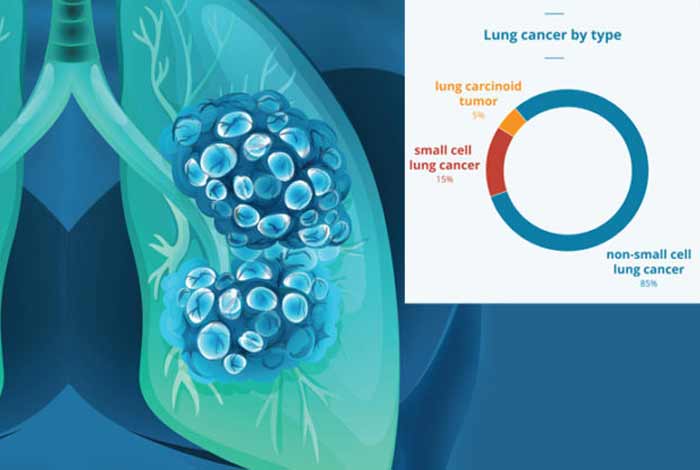
American Cancer Society lists down three major types of lung cancers, based on the appearance of the cancer cells under a microscope. [3]
These are described below.
1. Small Cell Lung Cancer: This is an uncommon variant of lung cancer, seen in 10 to 15% of cases. It is also known as Oat Cell Cancer. Although less common, it tends to spread rapidly and is a more aggressive form of lung cancer.
2. Non-small Cell Lung Cancer: It occurs more commonly, accounting for about 85% of cases of lung cancer. Non-small cell lung cancer is a broader term consisting of several forms of lung cancer, such as adenocarcinoma, large cell carcinoma and squamous cell carcinoma.
3. Lung Carcinoid Tumor: It is also known as Neuroendocrine tumor. These rarely occur in about 5% of cases of lung cancer. They are less invasive, grow slowly and have least tendency to spread.
Symptoms of Lung Cancer
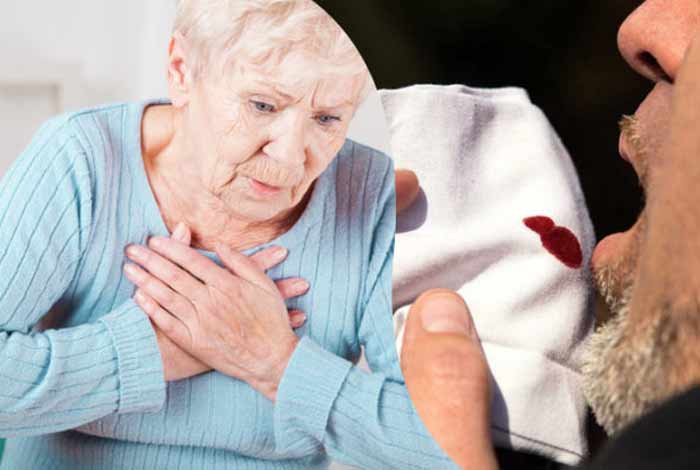
Lung cancer mostly affects people in their 70s and is rarely seen in young individuals. It is usually asymptomatic in its initial stages. However, in its advanced stages, it may produce some symptoms. These symptoms may vary based on the progression of cancer.
If lung cancer has not spread to distant organs, i.e., it has not metastasized and is confined to the lungs only, it may present with following features.
• A newly developed cough that doesn’t go away or worsen with time
• Coughing up blood (medically known as hemoptysis)
• A persistent dull, aching pain in the chest
• Shortness of breath usually occurs due to obstruction to the flow of air in lungs or collection of fluid in the pleura surrounding the lungs (medically referred to as pleural effusion), or due to complete involvement of lung by the tumor
• A wheezing or hoarseness may be seen due to lung obstruction
• Recurrent respiratory infections, such as pneumonia or bronchitis, are also suggestive of lung cancer
The metastasis or spread of lung cancer occurs in its advanced stages. It usually spreads to the liver, bones, adrenal glands and the brain. Hence, the symptoms differ based on the involved organ. These are described below.
• Involvement of liver may manifest as loss of appetite and an unexplained weight loss. It may also lead to jaundice, marked by yellow or pale skin and eyes
• Involvement of bones is most commonly seen with small cell lung cancers, However; other variants of lung cancer may also metastasize to bone. Commonly involved bones include backbone (vertebra), thigh bone (femur), ribs and the pelvic bone
• Metastasis of lung cancer to adrenal glands produce no symptoms
• Involvement of brain may lead to headache, seizures, visual disturbances and numbness in arms or legs
Tumors involving the top part of lung may affect the facial nerve, which supplies various organs, including eyes and face. Thus, it can cause drooping of eyelid, reduced size of pupil and no sweating on one side of the face. All these signs and symptoms together constitute a condition, known as Horner syndrome.
Another complication posed by any tumor is that the tumor cells may release chemicals, that in turn can produce symptoms in the distant organ. Also, sometimes the antibodies produced in response to cancer may affect healthy tissues. This is referred to as a paraneoplastic syndrome. The tumor cells of lung cancer may produce some hormones, which can cause several manifestations, as described below.
• Nausea
• Muscle weakness
• Vomiting
• High blood pressure
• Fluid retention
• Confusion
• High blood sugar
• Coma
• Seizures
Risk Factors of Lung Cancer
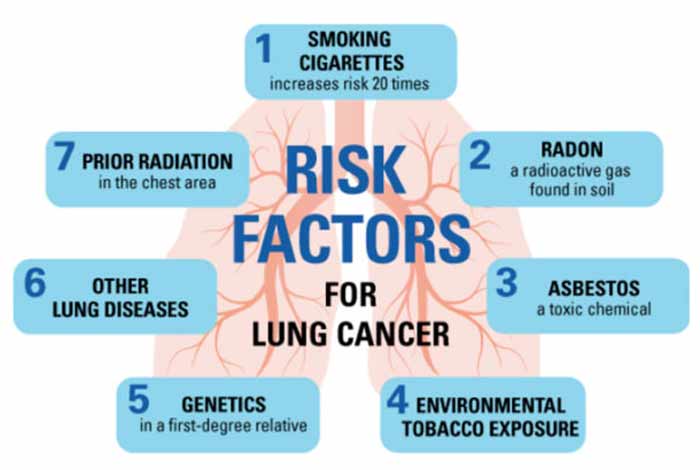
Although anyone can develop lung cancer, certain factors increase the risk of developing it. Center for Disease Control and Prevention enlists the following risk factors associated with lung cancer. [4]
1. Smoking: It is the biggest risk factor associated with smoking. Almost 80-90 % of lung cancer cases in the US occur due to smoking. Research has shown that cigarette smokers are 15 to 30 times more prone to develop lung cancer or die due to lung cancer as compared to non-smokers. It is a well-established fact that tobacco smoke contains more than 7,000 toxic chemicals, of which at least 70 chemicals have been linked with cancer. However, it must be noted that the number of cigarettes and the frequency of smoking is directly related to the risk of developing lung cancer, i.e., more cigarettes you smoke each day and more years you smoked, greater will be the chances of developing lung cancer.
Smoking is also related to other cancers, such as oral cancer, esophagus cancer, bladder cancer, pelvic cancer, pancreatic cancer and many more.
2. Secondhand smoke: Secondhand smoke, commonly known as passive smoking, also increases the risk of developing lung cancer. Recent estimates show that 7,300 people who are not active smokers die every year due to passive smoking.
3. Radon: It is a naturally occurring gas, present in dirt and rocks. It can enter our house through small cracks. We cannot see it or smell it, so it is indiscernible. The U.S Environment Protection Agency (EPA) reports that one in every 15 houses in US has radon and around 20,000 cases of lung cancer every year are radon-induced. [5]
4. Exposure to Other Substances: We may be exposed to other potential carcinogens at our workplace, such as arsenic, asbestos, diesel exhaust, chromium or silica. Long-term exposure to these substances increases our chance of developing lung cancer.
5. Previous History of Lung Cancer: If someone has survived lung cancer in the past, he or she is at higher risk of developing it again, especially if they smoke.
6. Family History: If your parents or siblings have a history of lung cancer, you are prone to develop it too.
7. Exposure to Radiation Therapy: Having a history of chest exposure to radiation therapy puts us at a higher risk of developing lung cancer.
8. Diet: Certain dietary factors may also make us more susceptible to develop lung cancer. It has been seen that smokers who consume beta-carotene supplements have a greater risk of developing lung cancer. Also, presence of arsenic in drinking water (mainly through private wells) puts us at greater risk of developing lung cancer.
Do I have it?
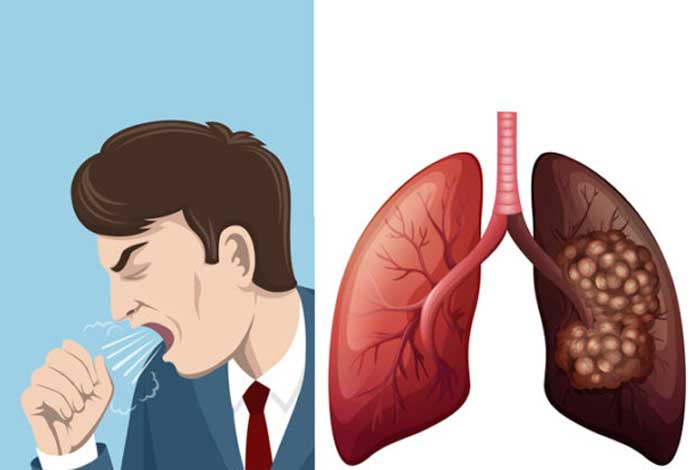
The most significant point to be noted is that if you are a smoker, you definitely are at a higher risk of developing lung cancer.
If you have a habit of smoking and have developed chest pain, shortness of breath, cough with or without blood, you must undergo screening to rule out lung cancer.
If you are in your 70s and have been a regular smoker, you are at a very high risk of developing lung cancer.
Also, if you are a passive smoker, i.e., your peers, friends or any family member smokes in your vicinity, you are susceptible to lung cancer.
If your occupation or your living conditions involve exposure to carcinogens, such as asbestos, arsenic, diesel exhaust, chromium or silica, you may develop lung cancer in the long run.
Causes of Lung Cancer

Smoking is considered the chief cause of lung cancer. However, it may affect anyone. In people who do not smoke or are not a secondhand smoker, the cause of lung cancer is unknown.
As per the Cancer Research Organization of UK, smoking tobacco can lead to lung cancer due to DNA damage. Certain chemicals present in cigarettes, such as polonium-201, benzene, nitrosamines and benzopyrene, damage the DNA and cancer-protecting genes of an individual. Other chemicals present in cigarette enhance the DNA damage. For example, chromium promotes the sticking of benzopyrene to the DNA, thus creating an even more deleterious effect. Also, chemicals such as nickel and arsenic hinder the repair pathway of the damaged DNA. This DNA damage along with its hampered repair leads on to the development of lung cancer.
However, the extent of DNA damage and the risk of developing lung cancer depends on the number of cigarettes smoked per day and the years spent in smoking. Research has shown that for every 15 cigarettes smoked, there is a pronounced DNA damage that can progress to lung cancer. [6]
Exposure to other environmental carcinogens, such as radon, asbestos, etc. are also the implicated causative factors of lung cancer.
Prevention of Lung Cancer
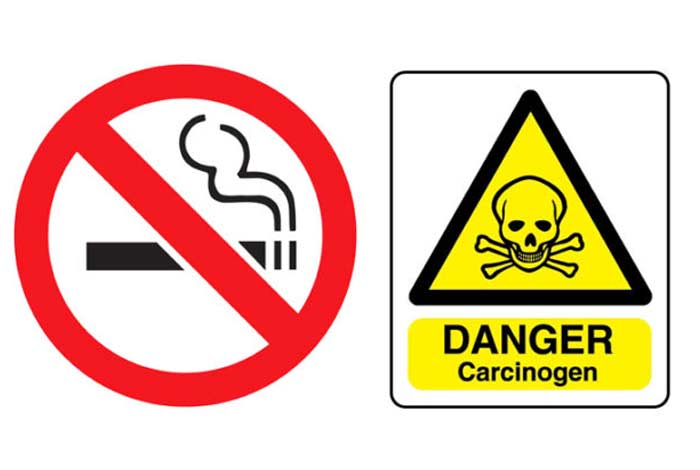
Owing to the fact that lung cancer is usually asymptomatic in its early stages and is usually diagnosed when it has advanced considerably, it is imperative to take preventive measures. Although not all lung cancers are preventable, American Cancer Society lists down certain measures to reduce the risk of developing lung cancer. [7]
These are described below:
1. Say No to Tobacco
It is a well-established fact that smoking or getting exposed to tobacco (secondhand smoke) in any form can lead to lung cancer. Also, when you quit smoking, your lung tissue may repair, irrespective of your age or the years you have spent smoking. Hence, quitting smoking is the foremost and most significant measure to prevent lung cancer. Medications and counseling can help reduce nicotine dependence if you are a chronic smoker.
Well-known Nicotine Replacement Therapy can curb your nicotine craving without providing you tobacco. These include some over-the-counter products such as nicotine patch, nicotine lozenge and nicotine gums. Some other products such as nicotine nasal spray and inhaler are also available on prescription. Some medications that lack nicotine, like bupropion, nortriptyline, varenicline are also available on prescription.
Another myth that prevails is that tobacco is harmful only in the form of cigarettes. Hence, many smokers replace their cigarettes with other forms of tobacco, like E-cigarettes, hookahs, pipes, cigars, etc. The fact is that tobacco in any form can cause lung cancer. Hence, refrain from smoking tobacco in any form.
2. Avoid Exposure to Carcinogens
Other than tobacco, other carcinogens such as radon, asbestos, and certain cancer-causing chemicals like uranium, arsenic etc. can also lead to cancer. Hence, avoid exposure to such carcinogens. Also, stay away from diesel exhaust and air pollutants as they can cause lung cancer.
3. Healthy Diet
The role of a healthy diet, including fruits and vegetables, in prevention of lung cancer needs more research to be well validated. Also, it must be remembered that the benefits of quitting smoking outweigh the beneficial effects of a healthy diet in prevention of lung cancer.
Screening of Lung Cancer
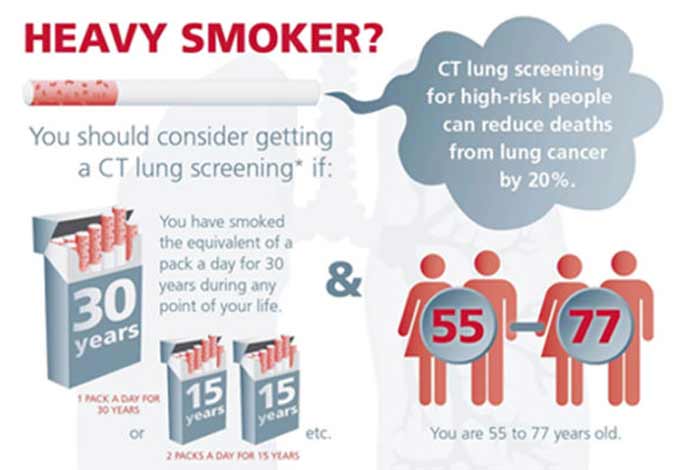
Lung Cancer is usually an incidental finding when an individual in undergoing medical examination for some other health condition. Mostly lung cancer presents with symptoms at an advanced stage, when cancer has reached a non-curable stage.
Looking at the high death rate associated with lung cancer, a Lung Cancer Screening Trial (LCST) was conducted to evaluate the role of a low-dose CT scan as a definitive screening test for susceptible patients. A notable fact here is that a screening test is not a diagnostic test, i.e., screening refers to identifying lung cancer in high-risk group of people who do not have any symptoms. By doing so, lung cancer can be identified at an early stage, thus improving the chances of a complete recovery. However, not all individuals should undergo the screening as CT scan involves a lot of radiation exposure. Thus, based on the LCST, certain guidelines were laid down to locate the individuals eligible to undergo screening.
These guidelines are as follows.
• Individual should be 55 to 74 years old
• Absence of any symptom and individual is in a fairly good health condition
• Should have a smoking history of at least 30 packs
• Is still a smoker or has quit smoking within last 15 years?
If an anomaly is noticed on screening, diagnostic tests are performed to confirm the diagnosis of lung cancer.
Diagnosis of Lung Cancer
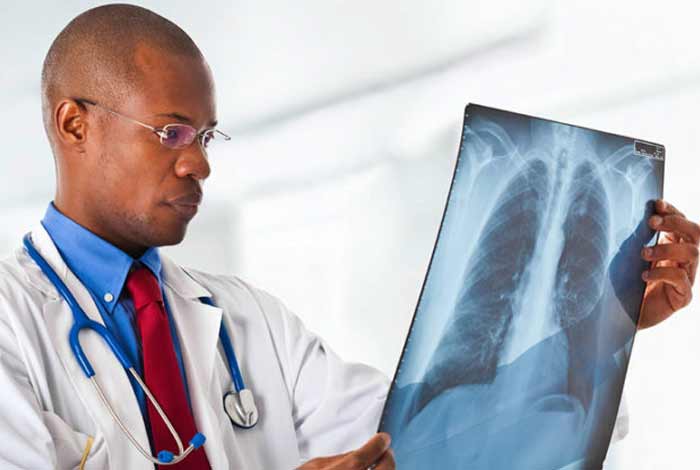
Various diagnostic tests used in the diagnosis of lung cancer are as follows.
1. Medical History and Physical Examination: Your doctor will take details regarding the symptoms you have been experiencing, such as the severity and duration of your symptoms. Following a thorough medical history, your doctors examine you to look for signs of lung cancer. This involves palpation of your chest area, hearing your lung sounds and checking for swollen nodes (suggestive of metastasis).
2. Chest X-ray: This is usually the first imaging test your physician may recommend on suspecting lung cancer. A white-grey mass can be seen in your chest X-ray that raises a stronger suspicion of lung cancer. However, other conditions, such as lung abscess (collection of pus in lungs) may also have a similar presentation.
3. CT scan: If chest X-ray shows a mass suggestive of lung cancer, your physician may refer you to a specialist, either a pulmonologist (lung specialist) or an oncologist (cancer specialist). These specialists may order a CT scan to get a higher resolution image of your lungs. A dye is injected which stains the mass (if present) in your lungs. After injecting dye and waiting for a while, a chest X-ray is taken and images are seen in a computer to look for dye-stained mass in the lungs.
4. Sputum Cytology: If you have been experiencing productive cough, i.e., cough with sputum production, examining the sputum under a microscope may reveal the presence of cancer cells.
5. PET-CT (Positron Emission Tomography-Computed Tomography) Scan: In this test, a radioactive dye is injected and then the lungs are examined under a PET scanner. Cancer cells can be effectively located through this scan.
6. Biopsy: It is usually the definitive test to diagnose any cancer. A biopsy refers to examining a section of lung tissue under a microscope, to look for cancer cells. Based on the method of collection of tissue, biopsy can be of several types.
I. Bronchoscopy: This procedure involves rendering your throat numb through a local anesthetic and then inserting a thin tube, known as bronchoscope through your mouth or nose, down into your throat, finally into your airway. A small portion of your lung tissue is then removed and sent to lab for microscopic examination.
II. Percutaneous needle biopsy: Following the administration of a local anesthetic, a needle is guided into your lungs with the help of a CT scanner. A small part of your lung tissue is then removed to be examined for the presence of cancer cells.
III. Thoracoscopy: It is a more invasive diagnostic test. It is usually done under a general anesthesia. Two to three cuts are made in the chest area and a tube is inserted into the lungs to remove a small part of tissue for examination.
IV. Mediastinoscopy: Mediastinum refers to the central body part between the lungs, seen in the midline. Mediastinoscopy involves an incision at the base of the neck, through which a tube is inserted and a part of lung tissue is removed.
7. Tests to Determine Stage of Cancer: Stage of cancer is assessed by determining the extent of metastasis of cancer. To determine the spread of lung cancer, various tests can be performed involving several organs to locate the cancer cells. These tests include X-ray, CT scan, MRI, PET-CT scan and bone scan.
Treatment of Lung Cancer
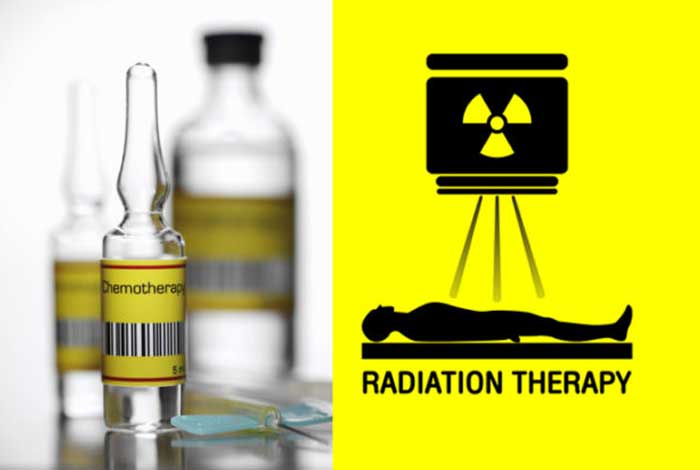
There are various treatment modalities that are advocated alone or in combination, to effectively treat lung cancer. Treatment is usually carried out by a team of specialists, who collaborate to determine the best treatment approach for the patient. The treatment is usually governed by certain factors, such as type of lung cancer (small cell or non-small cell lung cancer), stage of cancer (stage 0 to stage IV), the position and size of lung cancer and the overall health of the patient.
Several treatment options include, surgery, chemotherapy and radiotherapy. Surgery is usually reserved for cancers that have not spread extensively. If the cancer is small and is confined to the lungs, surgical removal of the mass is carried out. However, if the cancer is large and is confined to the lungs, chemotherapy or radiotherapy may be given prior to surgery to shrink the tumor, thus facilitating its easy surgical removal. Also, chemotherapy is usually administered after surgery to destroy cancer cells which may have escaped the surgery.
If cancer has spread to other organs, surgery is not carried out. Instead, radiotherapy alone, or in combination with chemotherapy (chemoradiotherapy) is advocated to destroy the cancer cells.
If cancer has spread too far and patient’s overall health cannot support surgery, radiotherapy may not be effective. In such cases, chemotherapy is the treatment of choice.
The various treatment modalities for lung cancer are described below.
1. Surgery
EEG and spirometry are done to assess your lung function before undergoing surgery. Surgery involves making an incision in the chest area and removing the cancerous lung tissue.
Lung is divided into several lobes and segments. Based on the extent of removal, there are mainly three types of surgeries done to counteract lung cancer. These are as follows.
I. Wedge resection or segmentectomy- This is usually indicated in lung cancers, involving a small segment of lung. This cancerous section of lung is surgically removed. Non-small lung cancers are usually treated by this procedure as these cancers are confined to small part of lung and are usually non-invasive.
II. Lobectomy- When lung cancer involves one or more larger section of lungs, i.e., lobes, their surgical removal is referred to as lobectomy.
III. Pneumonectomy- When cancer has involved the middle of the lung or has involved one entire lung, the respective lung is surgically removed. It is possible to breathe through one functioning lung. However, if patient complained of shortness of breath before surgery, the breathing distress may persist following pneumonectomy.
During surgical procedure, surgeon also removes the lymph nodes involved by cancer. An advanced surgical procedure, known as Video-assisted thoracoscopic surgery (VATS) has emerged as a minimally invasive surgical technique. As the name implies, surgery is assisted by a small fiber-optic camera that is inserted in the small surgical incision.
Surgery done for lung cancer may cause several complications, such as pneumonia, hemorrhage (i.e., excess bleeding) and deep vein thrombosis (a blood clot in deep veins of leg), which may eventually lead to pulmonary embolism (i.e., clot of leg may travel up to involve lungs)
2. Radiotherapy
This treatment modality is based on the use of radio waves to destroy cancer cells. Various types of radiotherapy that can be used are as follows.
I. Conventional External Beam Radiotherapy- This type of radiotherapy directs radiation beam to the tumor area, with the aid of a machinery. However, it may also expose the surrounding healthy tissues to the radiation beam.
II. Stereotactic Radiotherapy- It is also known as radiosurgery. It is a more conservative type of external beam radiotherapy. It specifically targets the tumor cells, without affecting the adjoining healthy tissues. Hence, these are exclusively indicated for lung cancers that are small and non-invasive.
III. Internal Radiotherapy- It involves placement of a radioactive material inside a tube (known as catheter) adjacent to the tumor tissue. The catheter is then removed after few minutes. Internal radiotherapy is not frequently used and is indicated for symptomatic relief when tumor is partially or completely obstructing the airway.
Although radiotherapy is effective, it has several side-effects such as fatigue, chest pain, persistent cough with mucous, trouble swallowing, red and sore skin, etc.
3. Chemotherapy
The drugs used for lung cancer involve group of cytotoxic drugs, which bear the potential to kill cancer cells. It can be given before surgery to shrink the tumor, or after surgery to kill remaining cancer cells, or to provide symptomatic relief and arrest the progression of cancer. It can sometimes be given in combination with radiotherapy.
These medications are usually given in the vein. However, capsules and tablets may also be given.
Side-effects seen with chemotherapy are nausea, fatigue, hair loss, vomiting and mouth ulcers. However, these side-effects disappear on cessation of treatment.
4. Other Treatment Modalities
Other than the conventional treatment approaches used in lung cancer, certain other methods may also be advocated. These are described below.
I. Biological Therapies- These are a targeted therapy which acts on specific anomalies present within the cancer cells. For example, growth factor inhibitors such as erlotinib and gefitinib hamper the growth of cancer cells, thus killing the cancer cells. However, they are used in certain cases of cancer, wherein the cancer cells have a specific protein on their surface. For example, gefitinib is used only if the cancer cells have a surface protein, known as Epidermal growth factor receptor (EGFR). Therefore, doctors run tests to determine whether a patient’s cancer cells have specific proteins, which can be blocked through medications or not.
II. Radiofrequency ablation- This procedure involves insertion of a needle in the tumor tissue of the lung, guided by a CT scanner. This is followed by transmitting radio waves through this needle. This generates excessive heat, which then kills the cancer cells.
A major complication associated with the condition is pneumothorax (entrapment of air in the pleural space surrounding the lungs). However, this complication can be counteracted by placing a drainage tube inside the lungs to escape the trapped air.
III. Cryotherapy- This procedure involves placing a cryoprobe inside the lung, close to the tumor tissue. It generates an extremely cold temperature, which kills the cancer cells. This therapy is indicated if the cancer cells are blocking the airway, producing symptoms such as, cough with or without blood and breathing distress.
IV. Phototherapy- This therapy is indicated in patients who are not willing to undergo surgery in spite of having lung cancer that is obstructing the airway. Phototherapy is done in two stages. The first stage involves injecting a medication in the tumor cells, making them more sensitive to light. After 24 to 72 hours, a laser beam is directed at the tumor site. Since, the tumor cells now bear more sensitivity to light, they undergo degeneration under the impact of a laser beam.
Side-effects of phototherapy include inflammation of the lungs and pulmonary edema (collection of fluid in the lungs).
Care for Lung Cancer

Family members and close ones can play a vital role in prevention of lung cancer. If your close one is a chronic smoker or lies in a high-risk group, encourage him/her to undergo screening for lung cancer despite the absence of symptoms. If diagnosed with lung cancer, it can be difficult for an individual to cope with. At this critical time, family, friends and peer support can of great significance. Make sure that the patient is attending doctor’s appointment timely. Provide appropriate emotional to the patient. If need be, consult a professional for psychological counseling. Motivate the patient to quit smoking. Treatments of lung cancer can render the patient physically and mentally weak. Help your close one with the day-to-day chores and try to ease up the journey of surviving cancer.
OTC Available for Lung Cancer
Owing to some major side-effects associated with drugs used in cancer, there are no over-the-counter drugs available for lung cancer. The role of vitamin supplements in the prevention and treatment of lung cancer is controversial. In fact, some studies have shown that beta-carotene (a precursor of vitamin A) can increase the risk of developing lung cancer. [8]
Self-Management Methods Available
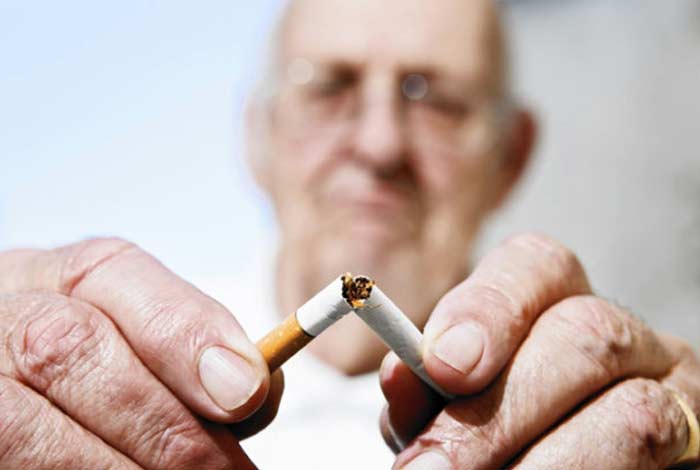
Lung Cancer is fatal cancer and requires medical intervention. However, there are several self- management methods that can complement the beneficial effects of medical therapy. These are described below.
1. Know about your condition- It is important to know the severity of your lung cancer in order to effectively manage the condition. Talk to your doctor about the stage of your cancer and discuss all your treatment options. Ask your doctor about the complications that may arise from these treatment methods.
2. Quit smoking tobacco- Lung cancer has a strong direct relation with smoking tobacco. Therefore, the most vital step to not just prevent, but to reap all the benefits of the treatment effectively, is to stop smoking. Seek professional help to de-addict yourself. Engage yourself in productive activities to avoid nicotine cravings. You may also incorporate several other measures to reduce your nicotine dependence, like nicotine products and non-nicotine medications (already discussed).
Quitting smoking can also keep you away from several other medical ailments such as COPD, stroke, asthma, coronary artery disease, diabetes, age-related macular degeneration, ectopic pregnancy, infertility in females and many other diseases.
3. Support Groups- There are several support groups of people trying to quit smoking. Joining such groups may prove effective in complete cessation of smoking.
Natural Ways to Cure Lung Cancer

Lung Cancer cannot be cured naturally. However, American Lung Association enlists several components of Complementary and Alternative Medicine (CAM) to manage the symptoms associated with lung cancer. [9]
These are described below.
1. Meditation- It has been used since long to curb various ailments. It involves a focused breathing or repeating words or phrases to calm the mind. It alleviates stress and can improve the life quality of cancer patients.
2. Hypnosis- It refers to a relaxed state of focused attention in which patient concentrates on particular feelings or ideas. It has been known to aid in healing in cancer cases.
3. Yoga- It involves a series of stretches and poses, with a concomitant focus on breathing. Yoga can relax the mind significantly and can relieve the anxiety and sleep disturbances associated with cancer.
4. Diet- A low-fat, high-fiber diet consisting of fruits and vegetables can help manage the symptoms of lung cancer. However, it is important to consult a professional to make necessary dietary changes.
5. Massage- It involves gentle manipulation of tissues with hands or with the aid of special tools. It helps in counteracting the anxiety and pain associated with lung cancer. A massage therapist trained to handle cancer cases must be consulted.
6. Acupuncture- It is a popular proponent of Chinese medicine which aims at stimulating specific points of the body to effectively manage pain and anxiety seen in lung cancer. It also relieves nausea and vomiting occurring as side-effects of cancer treatment.
Health Tip by Experts
According to experts, complete cessation of smoking is the key to avoid many health ailments, including lung cancer. Chronic smokers may be willing to quit smoking but are unable to do so, mostly due to lack of motivation. Experts advice such individuals to seek professional help as prevention is better than cure.
However, people diagnosed with the condition must not lose hope as at present, there are millions of survivors of lung cancer. A healthy lifestyle, attending medical appointments regularly and managing stress can do wonders in recovering from lung cancer.







